Mostrar el registro sencillo del ítem
dc.contributor.author
González Paleo, Luciana

dc.contributor.author
Vilela, Alejandra Elena

dc.contributor.author
Ravetta, Damián Andrés

dc.date.available
2018-05-31T14:50:14Z
dc.date.issued
2016-11
dc.identifier.citation
González Paleo, Luciana; Vilela, Alejandra Elena; Ravetta, Damián Andrés; Back to perennials: Does selection enhance tradeoffs between yield and longevity?; Elsevier Science; Industrial Crops and Products; 91; 11-2016; 272-278
dc.identifier.issn
0926-6690
dc.identifier.uri
http://hdl.handle.net/11336/46780
dc.description.abstract
Perennial plants allocate more resources belowground and have longer-lived leaves than their annual counterparts, which are the basis for the promotion of perennial crops towards a more sustainable agriculture. On the downside, perennial plants selected for high seed-yield might show tradeoffs between current reproduction and long-term reproduction or survival, raising the questions of whether this high yield can be sustained over time and whether such tradeoffs can be overcome through selection. We compared growth, reproduction and the storage of reserves, over 3 years in wild and high-yielding accessions of Physaria mendocina. We found evidence of a tradeoff between current and future reproduction, responsible for a decrease in yield with age, in selected accessions. Selected accession had 76% more accumulated seed-yield in relation to wild accessions, but they also concentrated seed-yield and had an enhanced harvest index in the first year. Wild accessions maintained seed production over time. Resources allocated to reproduction were limited for both root allocation and carbohydrate accumulation after the second year. Wild and selected accessions consumed half of their storage carbon during reproduction, but replenishment of storage organs was 60% lower in selected accession compared to wild ones. This response could be related to a lower recovery of the root system after senescence. Empirical information about the pattern of use of reserves and their relationships with the ontogenetic changes in leaf functioning and root architecture is crucial when defining new criteria of selection of perennial species, since they will influence longevity and yield stability.
dc.format
application/pdf
dc.language.iso
eng
dc.publisher
Elsevier Science

dc.rights
info:eu-repo/semantics/openAccess
dc.rights.uri
https://creativecommons.org/licenses/by-nc-sa/2.5/ar/
dc.subject
Physaria
dc.subject
Breeding
dc.subject
Trade-Offs
dc.subject
Seed Yield
dc.subject.classification
Agricultura

dc.subject.classification
Agricultura, Silvicultura y Pesca

dc.subject.classification
CIENCIAS AGRÍCOLAS

dc.title
Back to perennials: Does selection enhance tradeoffs between yield and longevity?
dc.type
info:eu-repo/semantics/article
dc.type
info:ar-repo/semantics/artículo
dc.type
info:eu-repo/semantics/publishedVersion
dc.date.updated
2018-05-29T20:58:34Z
dc.journal.volume
91
dc.journal.pagination
272-278
dc.journal.pais
Países Bajos

dc.journal.ciudad
Amsterdam
dc.description.fil
Fil: González Paleo, Luciana. Consejo Nacional de Investigaciones Científicas y Técnicas; Argentina. Museo Paleontológico Egidio Feruglio; Argentina
dc.description.fil
Fil: Vilela, Alejandra Elena. Consejo Nacional de Investigaciones Científicas y Técnicas; Argentina. Museo Paleontológico Egidio Feruglio; Argentina
dc.description.fil
Fil: Ravetta, Damián Andrés. Consejo Nacional de Investigaciones Científicas y Técnicas; Argentina. Museo Paleontológico Egidio Feruglio; Argentina
dc.journal.title
Industrial Crops and Products

dc.relation.alternativeid
info:eu-repo/semantics/altIdentifier/doi/https://dx.doi.org/10.1016/j.indcrop.2016.07.018
dc.relation.alternativeid
info:eu-repo/semantics/altIdentifier/url/https://www.sciencedirect.com/science/article/pii/S0926669016304630
Archivos asociados
